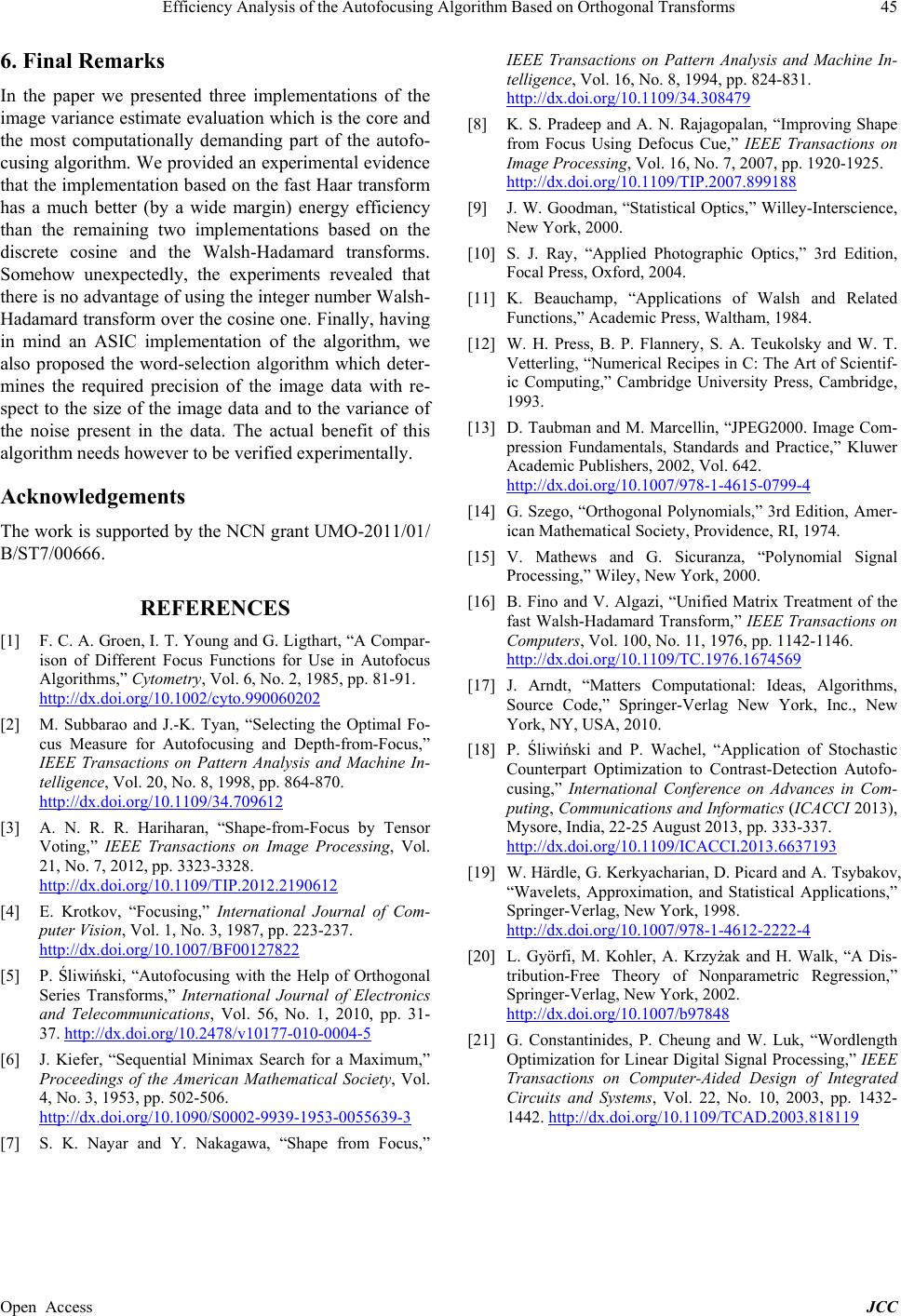
Efficiency Analysis of the Autofocusing Algorithm Based on Orthogonal Transforms
Open Access JCC
6. Final Remarks
In the paper we presented three implementations of the
image variance estimate evaluation which is the core and
the most computationally demanding part of the autofo-
cusing algorithm. We provided an experimental evidence
that the implementation based on the fast Haar transform
has a much better (by a wide margin) energy efficiency
than the remaining two implementations based on the
discrete cosine and the Walsh-Hadamard transforms.
Somehow unexpectedly, the experiments revealed that
there is no advantage of using the integer number Walsh-
Hadamard transform over the cosine one. Finally, having
in mind an ASIC implementation of the algorithm, we
also proposed the word-selection algorithm which deter-
mines the required precision of the image data with re-
spect to the size of the image data and to the variance of
the noise present in the data. The actual benefit of this
algorithm needs however to be verified experimentally.
Acknowledgements
The work is supported by the NCN gran t UMO-2011/01/
B/ST7/00666.
REFERENCES
[1] F. C. A. Groen, I. T. Young and G. Ligthart, “A Compar-
ison of Different Focus Functions for Use in Autofocus
Algorithms,” Cytometry, Vol . 6, No. 2, 1985, pp. 81-91.
http://dx.doi.org/10.1002/cyto.990060202
[2] M. Subbarao and J.-K. Tyan, “Selecting the Optimal Fo-
cus Measure for Autofocusing and Depth-from-Focus,”
IEEE Transactions on Pattern Analysis and Machine In-
telligence, Vol. 20, No. 8, 1998, pp. 864-870.
http://dx.doi.org/10.1109/34.709612
[3] A. N. R. R. Hariharan, “Shape-from-Focus by Tensor
Voting,” IEEE Transactions on Image Processing, Vol.
21, No. 7, 2012, pp. 3323-3328.
http://dx.doi.org/10.1109/TIP.2012.2190612
[4] E. Krotkov, “Focusing,” International Journal of Com-
puter Vision, Vol. 1, No. 3, 1987, pp. 223-237.
http://dx.doi.org/10.1007/BF00127822
[5] P. Śliwiński, “Autofocusing with the Help of Orthogonal
Series Transforms,” International Journal of Electronics
and Telecommunications, Vol. 56, No. 1, 2010, pp. 31-
37. http://dx.doi.org/10.2478/v10177-010-0004-5
[6] J. Kiefer, “Sequential Minimax Search for a Maximum,”
Proceedings of the American Mathematical Society, Vol.
4, No. 3, 1953, pp. 502-506.
http://dx.doi.org/10.1090/S0002-9939-1953-0055639-3
[7] S. K. Nayar and Y. Nakagawa, “Shape from Focus,”
IEEE Transactions on Pattern Analysis and Machine In-
telligence, Vol. 16, No. 8, 1994, pp. 824-831.
http://dx.doi.org/10.1109/34.308479
[8] K. S. Pradeep and A. N. Rajagopalan, “Improving Shape
from Focus Using Defocus Cue,” IEEE Transactions on
Image Processing, Vol. 16, No. 7, 2007, pp. 1920-1925.
http://dx.doi.org/10.1109/TIP.2007.899188
[9] J. W. Goodman, “Statistical Optics,” Willey-Interscience,
New York, 2000.
[10] S. J. Ray, “Applied Photographic Optics,” 3rd Edition,
Focal Pre ss , Oxford, 2004.
[11] K. Beauchamp, “Applications of Walsh and Related
Functions,” Academic Press, Waltham, 1984.
[12] W. H. Press, B. P. Flannery, S. A. Teukolsky and W. T.
Vetterling, “Numerical Recipes in C: The Art of Scientif-
ic Computing,” Cambridge University Press, Cambridge,
1993.
[13] D. Taubman and M. Marcellin, “JPEG2000. Image Com-
pression Fundamentals, Standards and Practice,” Kluwer
Academic Publishers, 2002, Vol. 642.
http://dx.doi.org/10.1007/978-1-4615-0799-4
[14] G. Szego, “Orthogonal Polynomials,” 3rd Edition, Amer-
ican Mathematical Society, Providence, RI, 1974.
[15] V. Mathews and G. Sicuranza, “Polynomial Signal
Processing,” Wiley, New York, 2000.
[16] B. Fino and V. Algazi, “Unified Matrix Treatment of the
fast Walsh-Hadamard Transform,” IEEE Transactions on
Computers, Vol. 100, No. 11, 1976, pp. 1142-1146.
http://dx.doi.org/10.1109/TC.1976.1674569
[17] J. Arndt, “Matters Computational: Ideas, Algorithms,
Source Code,” Springer-Verlag New York, Inc., New
York, NY, USA, 2010.
[18] P. Śliwiński and P. Wachel, “Application of Stochastic
Counterpart Optimization to Contrast-Detection Autofo-
cusing,” International Conference on Advances in Com-
puting, Communications and Informatics (ICACCI 2013),
Mysore, India, 22-25 August 2013, pp. 333-337.
http://dx.doi.org/10.1109/ICACCI.2013.6637193
[19] W. Härdle, G. Kerkyacharian, D. Picard and A. Tsybakov,
“Wavelets, Approximation, and Statistical Applications,”
Springer-Verlag, New York, 1998.
http://dx.doi.org/10.1007/978-1-4612-2222-4
[20] L. Györfi, M. Kohler, A. Krzyżak and H. Walk, “A Dis-
tribution-Free Theory of Nonparametric Regression,”
Springer-Verlag, New York, 2002.
http://dx.doi.org/10.1007/b97848
[21] G. Constantinides, P. Cheung and W. Luk, “Wordlength
Optimization for Linear Digital Signal Processing,” IEEE
Transactions on Computer-Aided Design of Integrated
Circuits and Systems, Vol. 22, No. 10, 2003, pp. 1432-
1442. http://dx.doi.org/10.1109/TCAD.2003.818119